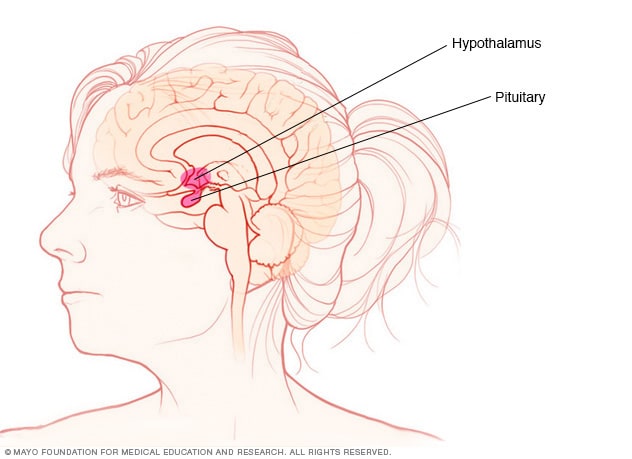Acromegaly
Acromegaly
overview
Illustration shows person with acromegaly

Illustration shows person with acromegaly
Symptoms of acromegaly include an enlarged face and hands. Changes in the face can cause the brow bone and lower jaw to become more prominent and the nose and lips to become larger.
Acromegaly is a hormonal disorder that occurs when your pituitary gland produces too much growth hormone during adulthood.
If you have too much growth hormone, your bones will increase in size. In childhood, this leads to an increase in height and is called gigantism. But no change in height occurs in adulthood. Instead, the increase in bone size is limited to the bones of your hands, feet, and face and is called acromegaly.
Because acromegaly is uncommon and the physical changes occur slowly over many years, it sometimes takes a long time for the condition to be recognized. If left untreated, high levels of growth hormone can affect other parts of your body besides your bones. This can lead to serious – sometimes even life-threatening – health problems. But treatment can reduce your risk of complications and significantly improve your symptoms, including the enlargement of your facial features.
Symptoms
A common sign of acromegaly is enlarged hands and feet. For example, you may notice that you can no longer put on rings that once fit and that your shoe size has gradually increased.
Acromegaly can also cause gradual changes to your face shape, such as: E.g. a protruding lower jaw and brow bone, an enlarged nose, thickened lips and a larger space between your teeth.
Because acromegaly tends to progress slowly, early signs may not be obvious for years. Sometimes people only notice the physical changes when they compare old photos with newer ones.
Overall, acromegaly signs and symptoms tend to vary from one person to another and may include any of the following:
- Vergrößerte Hände und Füße
- Vergrößerte Gesichtszüge, einschließlich Gesichtsknochen, Lippen, Nase und Zunge
- Grobe, fettige, verdickte Haut
- Übermäßiges Schwitzen und Körpergeruch
- Kleine Wucherungen von Hautgewebe (Hautanhängsel)
- Müdigkeit und Gelenk- oder Muskelschwäche
- Schmerzen und eingeschränkte Beweglichkeit der Gelenke
- Eine vertiefte, heisere Stimme aufgrund vergrößerter Stimmbänder und Nebenhöhlen
- Starkes Schnarchen durch Obstruktion der oberen Atemwege
- Sichtprobleme
- Kopfschmerzen, die anhaltend oder schwerwiegend sein können
- Menstruationszyklus Unregelmäßigkeiten bei Frauen
- Erektile Dysfunktion bei Männern
- Verlust des Interesses an Sex
When to go to the doctor?
If you have signs and symptoms associated with acromegaly, contact your doctor for an evaluation.
Acromegaly usually develops slowly. Even your family members may not initially notice the gradual physical changes that occur with this condition. However, early diagnosis is important so you can begin proper treatment. Acromegaly can lead to serious health problems if left untreated.
Causes
Pituitary gland and hypothalamus

Pituitary gland and hypothalamus
The pituitary gland and hypothalamus are located in the brain and control hormone production.
Acromegaly occurs when the pituitary gland produces too much growth hormone (GH) over a long period of time.
The pituitary gland is a small gland at the base of your brain, behind the bridge of your nose. It produces GH and a number of other hormones. GH plays an important role in controlling your physical growth.
When the pituitary gland releases GH into your bloodstream, it causes your liver to produce a hormone called insulin-like growth factor-1 (IGF-1) – sometimes called insulin-like growth factor-I or IGF-I. IGF-1 causes your bones and other tissues to grow. Too much GH leads to too much IGF-1, which can cause signs, symptoms, and complications of acromegaly.
In adults, a tumor is the most common cause of excessive GH production:
- Hypophysentumore. Die meisten Fälle von Akromegalie werden durch einen gutartigen (gutartigen) Tumor (Adenom) der Hypophyse verursacht. Der Tumor produziert übermäßige Mengen an Wachstumshormon, was viele der Anzeichen und Symptome der Akromegalie verursacht. Einige der Symptome der Akromegalie, wie Kopfschmerzen und Sehstörungen, sind darauf zurückzuführen, dass der Tumor auf benachbartes Gehirngewebe drückt.
- Nicht-Hypophysentumoren. Bei einigen Menschen mit Akromegalie verursachen Tumore in anderen Körperteilen, wie der Lunge oder der Bauchspeicheldrüse, die Erkrankung. Manchmal sezernieren diese Tumore GH. In anderen Fällen produzieren die Tumore ein Hormon namens Wachstumshormon-Releasing-Hormon (GH-RH), das der Hypophyse signalisiert, mehr GH zu produzieren.
Complications
If left untreated, acromegaly can cause major health problems. Complications may include:
- Bluthochdruck (Hypertonie)
- Hoher Cholesterinspiegel
- Herzprobleme, insbesondere Vergrößerung des Herzens (Kardiomyopathie)
- Arthrose
- Typ 2 Diabetes
- Vergrößerung der Schilddrüse (Kropf)
- Präkanzeröse Wucherungen (Polypen) an der Auskleidung Ihres Dickdarms
- Schlafapnoe, ein Zustand, bei dem die Atmung während des Schlafs wiederholt stoppt und beginnt
- Karpaltunnelsyndrom
- Erhöhtes Krebsrisiko
- Kompression oder Frakturen des Rückenmarks
- Sehstörungen oder Sehverlust
Treating acromegaly early can prevent these complications from developing or getting worse. If left untreated, acromegaly and its complications can lead to premature death.
Sources:
- Fragen Sie MayoExpert. Akromegalie und Gigantismus. Mayo-Klinik; 2019.
- Akromegalie. Nationales Institut für Diabetes und Verdauungs- und Nierenerkrankungen. https://www.niddk.nih.gov/health-information/endocrine-diseases/acromegaly. Abgerufen am 26. Dezember 2020.
- Kellermann RD, et al. Endokrine und Stoffwechselstörungen. In: Conn’s Current Therapy 2021. Elsevier; 2021. https://www.clinicalkey.com. Abgerufen am 26. Dezember 2020.
- Jameson JL, et al., Hrsg. Akromegalie: In: Endokrinologie: Erwachsene und Kinder. 7. Aufl. Elsevier; 2016. https://www.clinicalkey.com. Abgerufen am 26. Dezember 2020.
- Melmed S. et al. Behandlung von Akromegalie. https://www.uptodate.com/contents/search. Abgerufen am 4. Januar 2021.

 Suche
Suche
 Mein Konto
Mein Konto